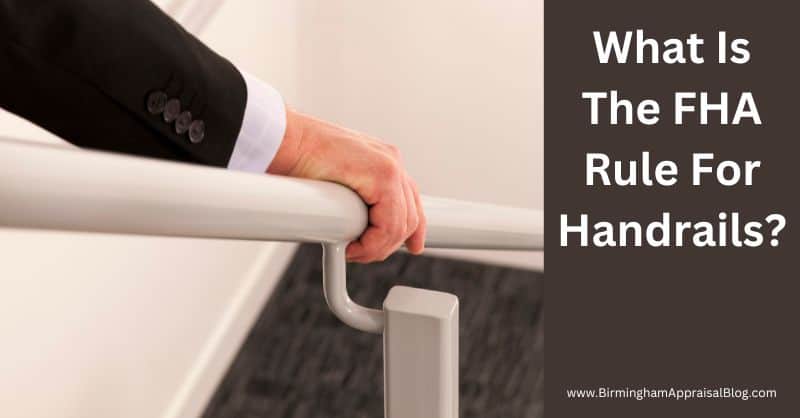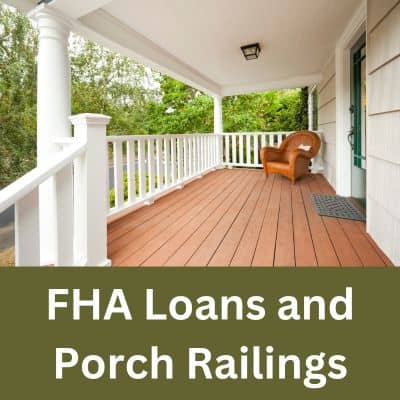
If you’re looking to purchase a home and you’re financing it with an FHA loan, the property will need to meet certain requirements to be approved for the loan. These requirements pertain to the handrails and porch railings of the property. In this blog post, we’ll discuss the FHA requirements for handrails and porch railings for an FHA appraisal.

Most people know that the FHA requirements for an FHA loan and appraisal are more stringent than a conventional loan. The requirements that are necessary to qualify for this type of loan are set up to help buyers successfully buy a home and pay back the mortgage.
In addition to assisting the buyer, steps are taken to insure that the collateral for the loan, which is the house, maintains its condition and value. This is important because if it is necessary to take the home back in foreclosure the lender wants to make sure they can sell the home for the money they have loaned on it.
Loans secured by an FHA mortgage must meet HUD Minimum Property Requirements or MPRs. These requirements fall under three primary categories and include the safety, soundness, and security of the property.
Items that fall under the safety category relate to the health, sanitary condition, and habitability of the property. Common types of problems include malfunctioning electrical service or even missing handrails on stairs.
Peeling or chipping paint can also affect the health and well-being of the occupants because it can be ingested and is poisonous. This is especially important if the home was built prior to 1978 when lead-based paint was used.
Items falling under the soundness category relate to the actual structure and the structural components. This includes the foundation, roof, and walls on the inside of the home and porches and decks on the outside. These components could have been built incorrectly or maybe deteriorated and rotted.
The last category is security; not so much the security of the house itself but of the ability of the home to serve as security/collateral for the loan. This could include its marketability (which may relate to the first two items). If a home is in such a state of disrepair that no one would want to buy it then it would not be good collateral. If the bank had to take the home back in foreclosure it would be very hard to resell it.
The topic of handrails that we are discussing today falls under the category of safety. These requirements are established to protect the health and safety of the occupants.
When discussing handrails there are two types that we will focus on. The first type is the handrails that are present on either side of a set of stairs. The second type is not necessarily handrails but rather railings that surround a porch or deck.
First off I want to note that the Federal Housing Administration (FHA) has stated that an appraisal can be completed as-is if the missing handrails do not pose a threat to safety. Because of this policy, it is up to the appraiser to make the determination as to what is safe and what is not.
So as you can see, there is some subjectivity involved. The appraiser will need to use their judgment to make a call on what needs to be done.
Handrails will need to be installed if there is a safety hazard that needs to be corrected. While there is no hard and fast rule it makes sense that a guideline we might use is to ask ourselves if we would feel safe if a toddler or senior citizen would be safe walking up or down the stairs.
If the answer is no then it might be safe to assume that handrails need to be installed. They will also need to be installed if they do not meet the local building codes.
HUD/FHA also states that “The Mortgagee must repair damaged or missing handrails or stair treads on elevated exterior porches, patios, decks, and balconies where the distance from the finished floor to the ground surface is greater than 18 inches. If repair is not feasible, the Mortgagee must provide temporary rails, fencing, or other means to prevent or mitigate falls.”
As you can see, FHA does provide some wiggle room when it comes to handrails but the bottom line is that there must not be a threat to the safety of anyone using the stairs.

Another related topic is that of porch railings and banisters. Again, there are rules for these items as well that are tied to safety.
A home being financed with an FHA loan must have porch railings and banisters installed if the porch (or deck) is higher than 30 inches. The railing must reach a height of at least 36 inches, which is mandated by the International Residential Code (IRC).
Conclusion
As you can see, the FHA rule for handrails is not as cut and dried as it use to be. Appraisers are given the discretion in some situations based on the safety risk of whether to require handrails on stairs.
The requirements for railings and banisters on porches and decks are a little more straightforward. Whatever the situation FHA guidelines should always be looked at through the lens of the three S’s which are Safety, Security, and Soundness.
If you have any questions related to this topic or any other FHA issue feel free to contact me and as always thanks for reading.
If you liked this post subscribe by email (or RSS feed).